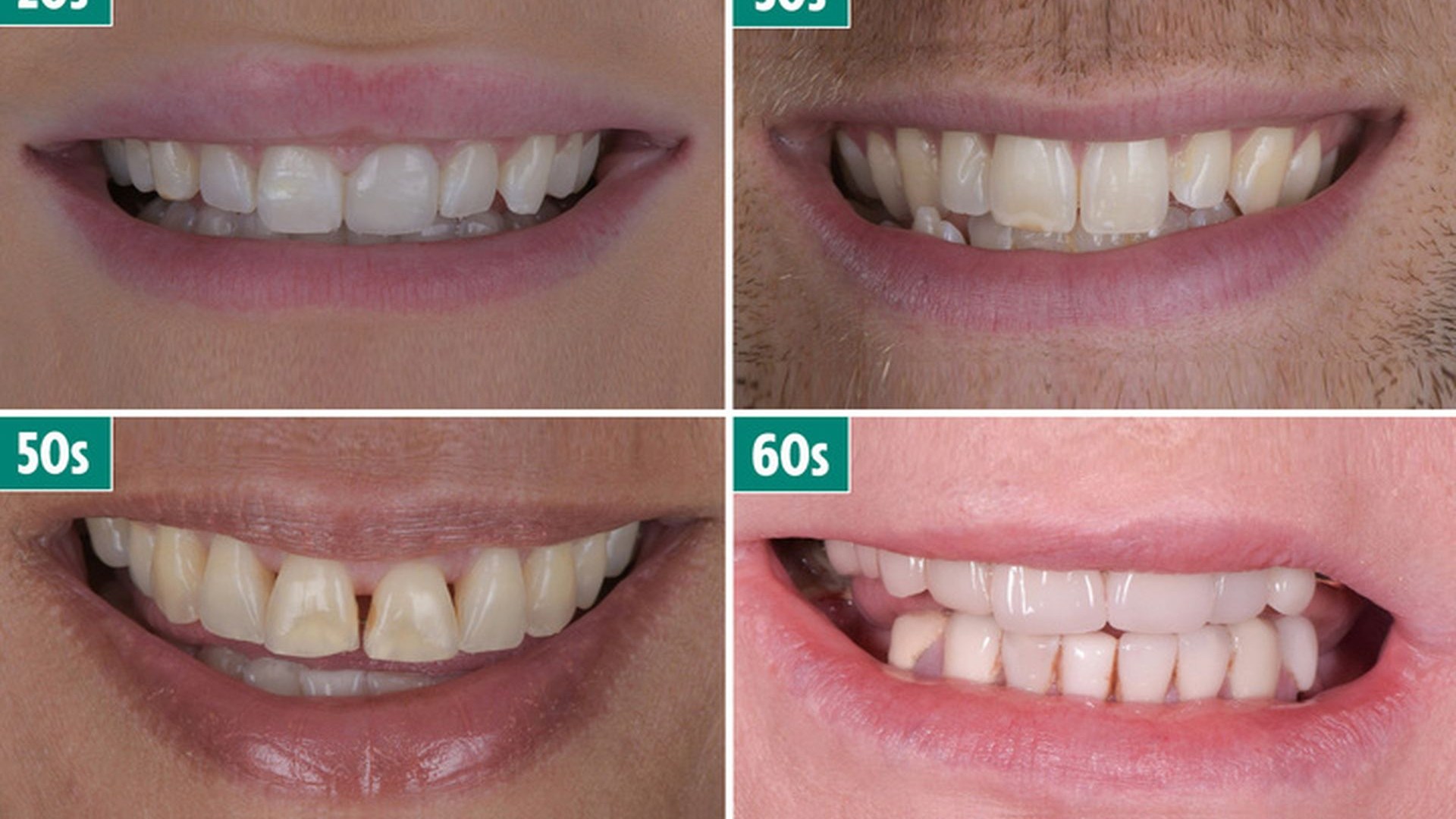CHILDHOOD and teenage years aren’t the only time in your life your teeth change.
The appearance of your gnashers continues to shift in your twenties up until your sixties – moving, thinning, crowding and maybe not looking so pearly white.
6
Many of these changes will happen gradually over time, but some dental issues will only emerge after you reach a certain age.
Cosmetic dentist and founder of the Marylebone Smile Clinic, Dr Sahil Patel, revealed key change you might notice as the years go by.
From teeth-crowding your twenties, to gum issues in your thirties, chipping in your forties, yellowing in your fifties and loosening your sixties – here’s what to expect from your teeth in each decade of your life and why.
Twenties

6
Your twenties is when your face – particularly the lower jaw – finishes growing, according to Dr Patel.
“This can cause some lower incisor crowding in your twenties,” the dentist said – these are the front teeth on your lower jaw.
Over time, crowding in your lower jaw can cause your teeth to look crooked.
But it also “increases the speed at which teeth are worn down”, Dr Patel added.
These kinds of dental issues mean many people in their twenties look into adult orthodontic options.
Dr Patel said Invisalign “is popular partly for this late growth that completes at age 21”.
At this age, you may also feel soreness at the back of your jaw, meaning your wisdom teeth are starting to peak through your gums.
This can often be pretty uncomfortable, and many twenty-somethings may choose to have the teeth removed.
If you decide to hold onto your wisdom teeth, keeping them and your back teeth clean can also be challenge.
You might be newly independent in this decade of your life, having moved out of your family home and earning your own money, so you might also look into elective cosmetic treatments to improve the look of your gnashers.
“Although the common first steps are whitening, composite bonding and alignment orthodontics, do careful research and do not jump into anything in a rush,” Dr Patel advised.
Thirties

6
As you enter your thirties, you may be choosing to start a family or pursuing career opportunities.
Exciting as these life phases are, they can also bring on stress – and see you grinding your teeth throughout the day or night.
“This accelerates tooth wear and can create small, flat and square teeth,” Dr Patel said.
“Pregnancy related gum issues combined with this makes your thirties a potentially damaging time for your teeth and smile.”
According to the NHS, hormonal changes during pregnancy can make your gums more vulnerable to plaque, leading to inflammation and bleeding. This is also called pregnancy gingivitis or gum disease.
“You can expect the teeth to continue to drift slowly in this decade, which exacerbates teeth crowding,” Dr Patel added.
You may also find yourself skipping dentist appointments due to work and family commitments or your packed social calendar, which can mean these teeth issues are being attended to.
“There is evidence that men seek dental treatment less frequently than women and have comparatively worse oral health outcomes as a result,” Dr Patel said.
Forties

6
Your smile might start to show signs of ageing in this decade of your life, as well as your skin or hair.
For starters, you might notice you’re showing more of your bottom teeth when you speak or break into a smile.
Dr Patel said: “This is due to two factors; the natural or accelerated wear of the edges of teeth, and the weakening of the collagen in our lips as we age, dropping them lower down on our face.”
Your teeth or fillings may also start to deteriorate in your forties too.
Are you brushing your teeth properly?
Brush your teeth with fluoride toothpaste twice a day for about two minutes to help keep your teeth and mouth healthy.
Plaque is a film of bacteria that coats your teeth if you don’t brush them properly. It contributes to gum disease and tooth decay.
Tooth brushing stops plaque building up. Try to make sure you clean every surface of all your teeth.
Brush your teeth for about two minutes last thing before you go to bed and on 1 other occasion every day.
Your dentist or hygienist may give you more advice based on your own dental health and needs.
It doesn’t matter whether you use an electric or manual toothbrush.
They’re both equally good, as long as you clean all the surfaces of all your teeth and you use fluoride toothpaste.
But some people find it easier to clean their teeth thoroughly with an electric toothbrush.
Source: NHS
“Tooth tissue is hard enough to last a lifetime, but it requires the input and care from a healthcare professional,” he said.
“Given no intervention in our forties, we can expect chipping, loosening of the ligament supporting the tooth, gum recession and yellowing of the colour.
“The most common interceptive treatments are ceramics to replace lost structure, strengthen the remaining tissue and rebuild natural aesthetics, or in some cases create a more youthful smile.”
Fifties

6
Though you might notice some gradual yellowing beforehand, you might notice discolouration getting worse in your fifties.
This is due to “pigments from food, drink and lifestyle habits penetrating deeper into the tooth and the nerve retreating from the tooth itself”.
Dr Patel warned: “Expect the edges of your teeth become squarer and smaller, with crooked teeth becoming commonplace in this decade.”
“Crowded and yellow teeth that bear the damage from many decades in use is to be anticipated.
“Improving the colour of teeth at this age is challenging due to the thinning enamel, so ceramics and implants are the most popular treatments.”
Sixties

6
As you ease into your sixties, you can expect to lose a tooth or two and you might need “significant dental work to maintain the teeth at their original shape and functionality”, Dr Patel said.
“There are very few people who will survive to 60 without some significant dental work or maintenance,” the dentist added.
As you advance in age, you might even start considering dentures.
But Dr Patel warned that dentures can be tough to maintain and even lead to a reduced quality of life.
Signs of disease in the mouth
Bad breath and mouth ulcers are common occurrences.
But they may signal an underlying health problem, too.
Dr Rahul Nehra, Lead Dentist at The Smile Gallery, warns of the symptoms in your mouth that should never be ignored.
BLEEDING GUMS
Persistent bleeding gums, especially during brushing or flossing, can indicate gum disease, such as gingivitis or periodontitis.
This is often caused by plaque buildup along the gumline, leading to inflammation and potential tissue damage.
It’s essential to address bleeding gums promptly to prevent further complications like gum recession and tooth loss.
For bleeding gums, proper oral hygiene is crucial, along with professional dental cleanings to remove plaque and tartar buildup.
BAD BREATH
Chronic bad breath, or halitosis, can be a sign of various dental issues, including poor oral hygiene, gum disease or cavities.
But it could be an underlying health problem such as diabetes or gastrointestinal issues.
Dental check-ups can help identify and address the root cause of bad breath, such as gum disease.
Improving bad breath typically involves maintaining good oral hygiene habits, such as brushing twice daily, flossing, and using an antimicrobial mouthwash.
LUMPS AND SORES
While occasional mouth sores are common and often harmless, persistent lumps or sores that don’t heal within two weeks could be signs of more serious conditions such as oral cancer.
Other concerning signs include white or red patches, numbness, or difficulty moving the jaw. If you notice any of these symptoms, seeing a dentist or doctor for further evaluation is crucial.
Sores in the mouth may benefit from topical treatments or medications prescribed by a dentist or doctor, while monitoring for any signs of infection or malignancy.
WOBBLY TEETH
Loose teeth can indicate advanced gum disease or untreated tooth decay.
Without prompt intervention, this can lead to tooth loss and bone deterioration.
Seeking dental care as soon as possible can help preserve remaining teeth, possibly through procedures like scaling and root planing or dental restorations.
SWALLOWING DIFFICULTY
Difficulty swallowing, also known as dysphagia, can be caused by various factors, including oral infections, inflamed tonsils, or even more severe issues like throat cancer.
If you experience persistent difficulty swallowing or a sensation of something stuck in your throat, it’s essential to seek medical or dental attention promptly for evaluation and appropriate treatment.
CROAKY VOICE
A croaky or hoarse voice can result from various conditions affecting the throat or vocal cords, including acid reflux, respiratory infections, or vocal cord nodules or polyps.
In some cases, poor oral hygiene or throat irritation can also contribute to voice changes.
If you experience persistent hoarseness or voice changes, it’s advisable to consult with a healthcare professional.
Addressing a croaky voice may involve lifestyle modifications, such as avoiding irritants like tobacco smoke or excessive vocal strain




